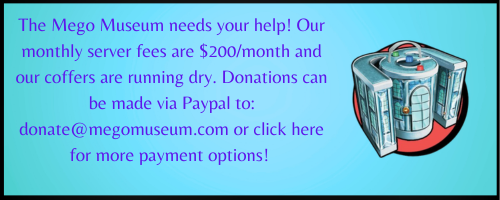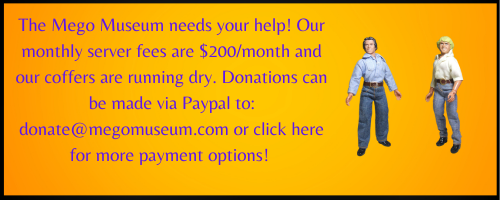There's so much in the book that makes me think, that I didn't know. Here's 10 things that the book taught me.
10. There's a Kitchen Sink Franken Captain America? I had no idea. Really? Wow.
9. I'd never noticed that the Batman and Robin belts came in 2 lengths, and that it started with the Fist Fighters. It's amazing to me that something short lived like the fighters would have lasting effects on the WGSH line.
8. Okay, I am not always the most observant Megohead, as you may have noticed. I had never thought about the fact that Green Arrow does not appear on anyone else's BOX. As the 7th DC character, there's no room for him on a 6 panel box, so his is unique. Yeah, I know, DUH, but I'd never put that together. That's cool. I always though that box was special.
7. The Tarzan chapter is incredible, I'm so thrilled to see original documenting letters between the liscense holders and Mego and Stan Weston. I had never really thought about ways they might have expanded Tarzan---Like the Tree House. Why they didn't simply repackage AJ's Jungle House is beyond me. It's a shame they didn't take advantage of the opportunity they had in getting the license so cheaply.
6. Maddie and David Abrams would have been responsible for the Alter Egos at Montgomery Wards. Fascinating. Is this why Dick Grayson's outfit has a Maddie Mod label? Strange coincidence.
5. The Jokermobile was something DC asked for and tried to introduce into the comics? I knew about the Spidermobile being a clumsy cross-over with Marvel, but this was new to me.
4. I'm obsessed with Mego catalogs and Christmas catalogs, so the box about the timeline for getting product into Christmas catalogs is filled with things I didn't know--directly from the source. knew catalogs were important, but I never appreciated how critical they were to so many decisions Mego made.
3. The reasons for the rarity of the Carded Iron Man, Lizard and Falcon really becomes clear. It's heartbreaking to consider how briefly they were released on cards. It makes me question how long they were released in boxes or what the ratio of cards to boxes was during the transition, because these characters themselves are not that rare, it's just that package that's impossible.
2. The decline of the WGSH is vividly, sadly illustrated here. WGSH was cancelled before Mego went bankrupt. I did not know that. Mego cancelled the WGSH--Damn them! Then they deserved to go bankrupt! Just kidding...kinda. It makes the 1978 Reimagine project all the more interesting to me, because that truly was the crossroads moment when they could have expanded and energized the property, but instead it began to go fallow. The book beautifully laments this loss.
1. I mentioned it before, but it's still the fact that blows me away the most and is central to the whole WGSH story. Stan Weston took this idea to FIVE DIFFERENT manufacturers before little pip-squeek Mego picked it up. Superheroes today are a multi-billion dollar industry with a marketing machine that is truly terrifying. In 1972 they could be had for a mere $50,000 and turned a novelty company into a giant. They may have miscalculated in declining Star Wars, but they said yes at the right time to Superheroes. Weston's role in this line has been forever enshrined in this book and that's a great service.
Thanks, Ben!
10. There's a Kitchen Sink Franken Captain America? I had no idea. Really? Wow.
9. I'd never noticed that the Batman and Robin belts came in 2 lengths, and that it started with the Fist Fighters. It's amazing to me that something short lived like the fighters would have lasting effects on the WGSH line.
8. Okay, I am not always the most observant Megohead, as you may have noticed. I had never thought about the fact that Green Arrow does not appear on anyone else's BOX. As the 7th DC character, there's no room for him on a 6 panel box, so his is unique. Yeah, I know, DUH, but I'd never put that together. That's cool. I always though that box was special.
7. The Tarzan chapter is incredible, I'm so thrilled to see original documenting letters between the liscense holders and Mego and Stan Weston. I had never really thought about ways they might have expanded Tarzan---Like the Tree House. Why they didn't simply repackage AJ's Jungle House is beyond me. It's a shame they didn't take advantage of the opportunity they had in getting the license so cheaply.
6. Maddie and David Abrams would have been responsible for the Alter Egos at Montgomery Wards. Fascinating. Is this why Dick Grayson's outfit has a Maddie Mod label? Strange coincidence.
5. The Jokermobile was something DC asked for and tried to introduce into the comics? I knew about the Spidermobile being a clumsy cross-over with Marvel, but this was new to me.
4. I'm obsessed with Mego catalogs and Christmas catalogs, so the box about the timeline for getting product into Christmas catalogs is filled with things I didn't know--directly from the source. knew catalogs were important, but I never appreciated how critical they were to so many decisions Mego made.
3. The reasons for the rarity of the Carded Iron Man, Lizard and Falcon really becomes clear. It's heartbreaking to consider how briefly they were released on cards. It makes me question how long they were released in boxes or what the ratio of cards to boxes was during the transition, because these characters themselves are not that rare, it's just that package that's impossible.
2. The decline of the WGSH is vividly, sadly illustrated here. WGSH was cancelled before Mego went bankrupt. I did not know that. Mego cancelled the WGSH--Damn them! Then they deserved to go bankrupt! Just kidding...kinda. It makes the 1978 Reimagine project all the more interesting to me, because that truly was the crossroads moment when they could have expanded and energized the property, but instead it began to go fallow. The book beautifully laments this loss.
1. I mentioned it before, but it's still the fact that blows me away the most and is central to the whole WGSH story. Stan Weston took this idea to FIVE DIFFERENT manufacturers before little pip-squeek Mego picked it up. Superheroes today are a multi-billion dollar industry with a marketing machine that is truly terrifying. In 1972 they could be had for a mere $50,000 and turned a novelty company into a giant. They may have miscalculated in declining Star Wars, but they said yes at the right time to Superheroes. Weston's role in this line has been forever enshrined in this book and that's a great service.
Thanks, Ben!




Comment